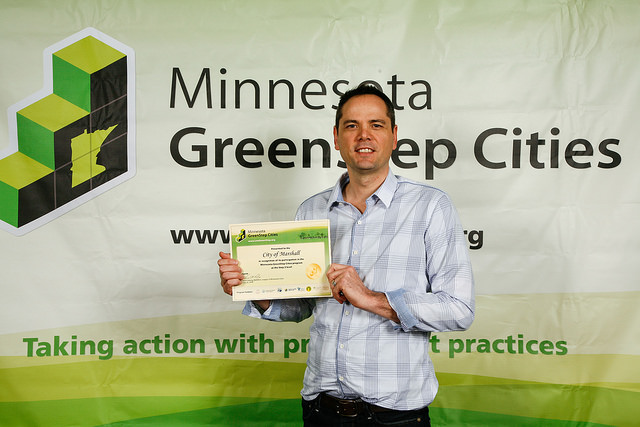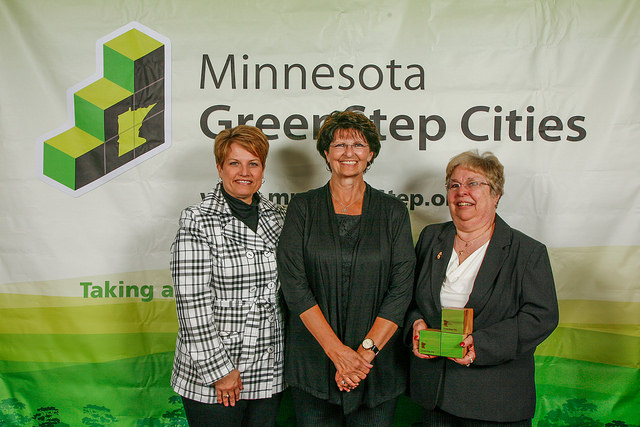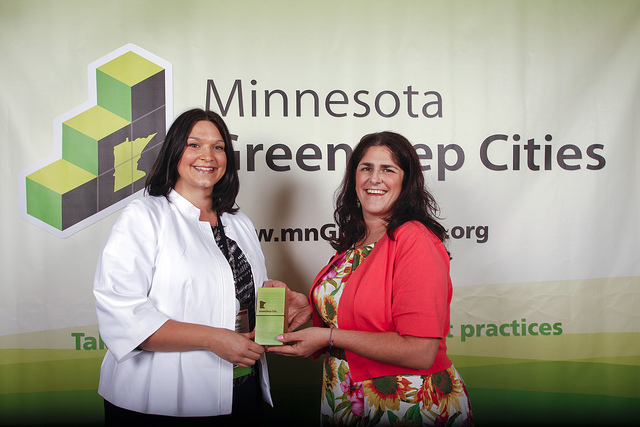The Minnesota GreenStep Cities program is designed to challenge, assist, and recognize Minnesota cities that are “green stars.” Cities are challenged to work through a series of steps—and recognized for steps they’ve already taken—that increase the community’s sustainability.
Each city is assigned a category based on how many public buildings it owns, its employee count, what kinds of facilities and services it offers, and other characteristics. Its category determines how many best practices a community needs to implement to achieve full GreenStep status, and makes the goal reachable for both small towns and large cities.
The program assists cities by providing a framework for sustainability improvements. The program web site lists the GreenStep 28 best practices for cities, offers model ordinances, and has tools to make planning and tracking activities easy. By spelling out best practices and the actions needed to implement them, the program gives city administrators a clear path to making their communities more energy efficient, healthy, and green. Cities report on their progress and are recognized for their incremental achievements.
There are 69 Minnesota cities in the program now. Here, we highlight three of very different sizes, settings, and challenges to show the range of what’s possible in communities striving for sustainability.
Marshall

Ben Martig receives the GreenStep Cities Award for the city of Marshall
Marshall, a city of 13,700 in southwest Minnesota, joined the GreenStep Cities program in March 2012. Program activities are overseen by a volunteer committee of public employees, business people, and others. Tom Hoff, Marshall’s volunteer GreenStep city coordinator, notes that the program has not cost the city any money. “We set out to prove that we can make some changes without increasing the city’s budget,” he says.
He’s been helped along this year by Melinda Kawalek, a member of Minnesota GreenCorps (a program coordinated by the MPCA that places AmeriCorps members with organizations to do focused environmental work). Hoff says Melina “has increased the amount of projects we’ve been able to accomplish.” Melinda’s term of service is up soon, but Hoff says they’ve applied for another GreenCorps member next year.
One of projects she’s worked on is soliciting applications for the Marshall GreenStep Business Recognition award, which recognizes businesses that are conserving resources and “taking the environment into consideration,” Hoff says. Almost 30 businesses have met the criteria and garnered a mention in the local paper and recognition on the city’s GreenStep page and by the local Chamber of Commerce.
Another major initiative the committee is working on is litter. “Marshall had always been recognized as a clean community,” Hoff says, “but that’s begun to change.” There have been recent complaints about litter around the city. The GreenStep program organized an event at which volunteers not only picked up trash in a particularly littered vacant lot, but also analyzed the litter to get some idea of where it came from. Hoff’s team has formed a stakeholder group that includes area business, waste haulers, city employees, and members of the Chamber of Commerce to try and solve the litter problem without new city regulations or ordinances. They hope that by identifying the origins of the trash, they can find common-sense ways to keep it in check. The group is also looking at a citywide litter reduction effort that will tap GIS mapping experts at Southwest Minnesota State University in Marshall to create a map of litter concentrations around the city and, again, try to determine the origins of the trash.
Hoff says that he and his GreenStep cohorts were not interested in just cosmetic changes or green proclamations. They wanted to do real work that resulted in changes that residents would recognize and appreciate.
Silver Bay

(L to R) Lana Fralich, Joanne Johnson & Carlene Perfetto receive the GreenStep Cities Award for the city of Silver Bay
Silver Bay, a city of 1,867 on the North Shore, joined the GreenStep Cities program in January. The community has tied its environmental efforts to its economic development activity, hoping to enhance both. Recognizing that development in the area can be at odds with protecting its natural resources — Lake Superior, forests, and animal habitat — the city decided to transform an existing business park into an “eco-industrial” facility. Using funding from a variety of agencies and organizations, including the MPCA, the city created a biofuel and food greenhouse in the industrial park to raise fish and vegetables for human consumption, and algae. Oil is extracted from the algae for the production of biofuel and the remaining algae material is fed to the fish.
The city also proposed the creation of Silver Bay Renewable Energy, a publicly owned utility service for the generation of renewable heat and power. In addition to biodiesel made with algae oil, the service would generate energy from biomass, wind, and solar power. The revenue from the utility would help sustain the eco-industrial park, in addition to providing jobs and energy to Silver Bay.
Oakdale

Jennifer Hassebroek, Senior Community Development Specialist with the City of Oakdale, accept their GreenStep award
St. Paul suburb Oakdale joined the GreenStep program in March 2011, and it’s overseen by the city council and an environmental management commission. Well before joining the program, Oakdale (population 27,378) had been working hard on being a green city. It focused its sustainability efforts on inventorying its greenhouse gas (GHG) emissions and establishing emission reduction targets. The city tracked energy use in public buildings and facilities and used software to calculate its GHG emissions. Once the inventory was complete, the city set a 13% reduction goal — and achieved it in 2013.
With the help of Xcel Energy, the city found ways to conserve energy that included furnace and air conditioner upgrades and roof and insulation work. The city hall building got an energy-efficient white roof and upgraded insulation. Residents are also encouraged to reduce their energy consumption through public workshops and other outreach.
Oakdale also applied for and received federal money to make energy efficiency improvements at its public works and city hall facilities. The upgrades include a new geothermal heating and cooling system and energy-efficient lighting for the public works building, and an energy-saving rooftop air conditioner, new boilers, and solar panels for city hall. The changes are estimated to save the city more than $18,000 each year.
The city has also exceled in promoting green building principles. Since 2001, city policy calls for any new construction or major remodel of a city facility to be built using Oakdale’s Generation Green building program standards, which include increased wall/roof insulation standards, use of recycled construction materials, native habitat landscaping, and upgraded HVAC equipment and controls. As a result, a building addition at public works, a new fire station, and the Discovery Center at Oakdale Nature Preserve were all built to the Generation Green standard.
Hear from more participating cities
Check out the video below to hear about the experiences of participating cities, and download a testimonial sheet where more cities share their thoughts.
For more information
For more information about Minnesota GreenStep Cities, contact Phil Muessig, Program Coordinator, at 651-757-2594, or visit the Minnesota GreenStep Cities website. You can also check out the presentation and map below.
See the original post on the MPCA website >>
About the Local Government Energy Action Series:
This effort tells the stories of Minnesota municipalities, counties, and schools and the tangible results of their energy-saving efforts to inspire others to take their own actions.


